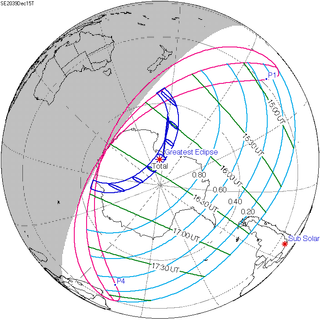| Solar eclipse of December 15, 2039 | |
|---|---|
| Type of eclipse | |
| Nature | Total |
| Gamma | −0.9458 |
| Magnitude | 1.0356 |
| Maximum eclipse | |
| Duration | 111 s (1 min 51 s) |
| Coordinates | 80°54′S 172°48′E / 80.9°S 172.8°E |
| Max. width of band | 380 km (240 mi) |
| Times (UTC) | |
| Greatest eclipse | 16:23:46 |
| References | |
| Saros | 152 (14 of 70) |
| Catalog # (SE5000) | 9596 |
A total solar eclipse will occur at the Moon's descending node of orbit on Thursday, December 15, 2039,[1] with a magnitude of 1.0356. A solar eclipse occurs when the Moon passes between Earth and the Sun, thereby totally or partly obscuring the image of the Sun for a viewer on Earth. A total solar eclipse occurs when the Moon's apparent diameter is larger than the Sun's, blocking all direct sunlight, turning day into darkness. Totality occurs in a narrow path across Earth's surface, with the partial solar eclipse visible over a surrounding region thousands of kilometres wide. Occurring about 4.5 hours before perigee (on December 15, 2039, at 20:55 UTC), the Moon's apparent diameter will be larger.[2]
The totality of the eclipse begins in the southern Pacific Ocean, passing over much of Antarctica and closely reaching the South Pole. A partial eclipse will be visible in the southern extremities of South America and Africa. It will terminate in the southern Indian Ocean several hours later.[3]
- ^ "December 15, 2039 Total Solar Eclipse". timeanddate. Retrieved 14 August 2024.
- ^ "Moon Distances for London, United Kingdom, England". timeanddate. Retrieved 14 August 2024.
- ^ "Path of Total Solar Eclipse of 2039 Dec 15". NASA Goddard Space Flight Center Eclipse Website. NASA. Retrieved 9 September 2017.
